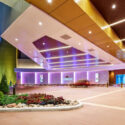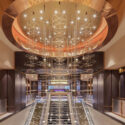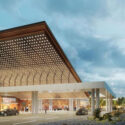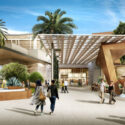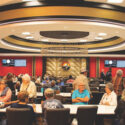
The needle of finance has moved.
Optimism sprouts from rising new gaming structures. Born from the world of architectural plans, optimistic chatter and concrete pours, they denote tribal expectation for growth.
Slowly, the industry walks further away from the Great Recession. Steadily, tribal entities ponder aggressive, not defensive postures. Should they expand or merely refresh the property to attract more attention? Where do the concepts of restaurants and entertainment venues fit? Where and how should tribal themes be expressed?
This question range is far more attractive than “How should jobs be saved?” Yes, some larger companies battle massive debt, but gaming in general has a launched a comeback.
A tentative, but widening grin dots gaming’s multibillion-dollar terrain.
A Chief Asset
The tribal market remains bullish, according to Chief Boyd, CEO and principal of Oklahoma-based Thalden Boyd Emery (TBE) Architects. Boyd recalls several financial cycles in more than 50 years of design experience, and likes the one he sees now.
“Many tribes are coming in, basically improving their projects and facilities,” he says. “We have got a few things going most of the time. You’ll see a situation in which the tribe may have grown, but in an awkward way, where perhaps they have expanded the casino a bit and now they need more amenities to balance the situation. Or perhaps they have a casino, but now they need a hotel.”
One illustration of smart growth features the Shoshone-Bannock Tribe in Idaho. TBE is helping the tribe replace a casino and connect it to the hotel. About 100 yards separate the hotel and casino now. Closing that football-field-sized gap will put prominent financial points on the board.
“Typically, if you are in a casino and the weather is not right, the tendency is to get up in the morning, check out of the hotel and leave,” Boyd says. “But if you get up and the casino is right there, figure for a big chance that the customers will game before they head out.
“The value of attaching the hotel to the casino is huge for another reason, which is why we encourage a lot of tribes to do it. If players are big gamers, just comp them for the room. Let’s say you determine that the value of a hotel night is $150. You comp that player, and as far as he is concerned, that’s free money. The first thing he is going to do is game for $150. Attaching the hotel to the casino extends the stay of the gamer.”
Blaine Edmo, chairman of the Tribal Council for Shoshone-Bannock, says his property embraces two trends. One is great geography. His competition is several hours away in all directions. Second, he believes the tribes have benefited from wise growth.
“They are a little more responsible in maintaining a certain level of business,” he says. “The tribe tries to keep it at a reasonable level, not the type of extravagance you see in many other places. I know many of them are lavish and impressive, but expensive. People who come to gamble come for the atmosphere, and as long as you have a clean facility and you are not overly congested, people will come. What you have to avoid, however, is a casino that looks run down.”
While broad expansion strokes may be apparent, the subtleties of when to build and how expensive to go remain tricky forecasts. Boyd says his company will double the size of a hotel at the Indigo Sky Casino for the Eastern Shawnee in Oklahoma after watching its initial suggestions rejected.
“We are building another hotel tower and a convention center, along with expanding some of their food venues,” Boyd indicates. “We built the first one for them four years ago, and they are turning people away. We recommended a bigger hotel in the beginning, but they wanted to go at it cautiously, which we certainly understand.”
A cautious buildout is usually smart; most businesses err in the opposite direction. They overbuild, inflate the perceived market and suffer huge losses. The fact that some officials may later kick themselves for not building sooner is a nice problem. This boom would have been hard to forecast in the midst of the Great Recession.
Thalden Boyd Emery already lent a creative hand in building the property.
Indigo Sky graces the rolling, wooded hills of northeast Oklahoma. An economical way to give the site a natural feel was to level the site, which was a rocky hill. TBE blasted the site and brought in a heavy-duty crusher. Major pieces of the rock were used in bank stabilization, and made 45,000 tons for the rock base for parking and building pads.
The tribe also wanted the swan (symbolic of the tribe’s grace and dignity) and panther (symbolic of the tribe’s strength, courage and prowess in battle) in their project. The symbols are incorporated into the water feature at the porte cochere.
Renovate, Innovate
“The market shows a combination of renovation and addition,” says Brett Ewing, associate principal for Minnesota-based Cuningham Group, which has specialized in tribal gaming since the 1980s. “As gaming has expanded and proliferated everywhere, the customers have become more savvy,” Ewing says. “Gaming is still strong in the Native American market and continuing to grow.
“Renovations are, by design, messy. There are surprises when you open up the old walls, things the drawings don’t generally tell you. Yet, your operators want to run the business while they are working on it. You are, in a sense, doing surgery on somebody and keeping them alive while you are doing it.”
Some of Cuningham’s recent projects reveal different elements of flexibility. One of them is the new luxury hotel for the Yavapai-Apache Nation’s Cliff Castle Casino in Arizona. Cuningham will do the architecture and interior design on a project slated for 2016. The existing business model is a two-story hotel about half a mile away from the gaming space. A Dreamcatcher hotel will be built, the casino will be connected to the hotel and there will be a parking structure and multi-purpose room.
Flexibility is one aspect of casino design. Volatility, and its ramifications, presents another. The Cypress Bayou Casino Hotel in Charenton, Louisiana, belonging to the Chitimacha tribe, has officials crossing their fingers, holding their breath and proceeding with faith. The casino renovation, with Cuningham providing architecture and interior design, unfolds with uncertainty. Oil prices substantially affect this property, which taps the southern Louisiana and Texas markets.
“When oil prices plummeted, it raised concerns regarding employees of the companies in that area,” Ewing says. “If they lose their jobs, the casino may lose customers. Fortunately for all of them, oil prices are coming back at this time.”
The dilemma indicates the power of precise planning. If oil prices plunge mid-project, the company must usually live with the consequence.
The Little River Casino Resort renovation and expansion in Manistee, Michigan, offers another lesson. Cuningham provided master planning, architecture and interior design for the renovation of the main lobby, casino and buffet and the addition of a
new sports bar, steakhouse and spa/salon/pool area. The client is the Little River Band of Ottawa Indians.
“We probably spent close to a year and a half finalizing that plan,” Ewing explains. “What we can tell clients is that the best use of your funding is during the planning and paper phase. That’s when you can turn over everything and can eliminate potential problems. Once you start digging and pouring concrete, that’s when the money is going to be spent. Those that can afford to be patient—carefully studying potential pitfalls—benefit in the long run.”
Ewing says tribal philosophies vary regarding cultural expression. Most want some form of it, many will reserve it for their museum and others will weave accent pieces like art or a basket pattern into the carpeting. Hotel rooms and lobbies provide the best vehicle for cultural expression.
“Something always fun and interesting is knowing that a family comes with these projects,” Ewing says. “In the non-tribal world, MGM can go buy Wynn, but a tribe is always a tribe. They are never going to be merged. They are creating their projects for generations. We always have a liaison between the tribal family and ourselves.”
Maximize Space
“For many gaming tribes across the country, a challenge is not trying to figure out what to new-build next (unless market opportunities and demand warrant), but how to aggressively maximize or reinvent every square foot of existing space,” says Dike Bacon, principal for the Memphis-based Hnedak Bobo Group, which has a rich tradition with tribal gaming projects.
“Many larger, older facilities were designed and built during times when excess or underutilized space was of no consequence,” Bacon says. “Public spaces, lobbies, casino floors, guest rooms, and many backs of houses were huge simply because they could be, and they got financed. There are always plenty of opportunities to renovate and refurbish, but often the biggest opportunity to directly affect the bottom line is to adaptively repurpose these kinds of inefficient existing spaces into new non-gaming revenue generators and entertainment experiences.”
The changes don’t always have to entail bells and whistles. They can be subtle.
“Things don’t have to be overcomplicated,” Bacon says. “Maybe inject some old-school glamour and turn an oversized lobby into an elegant, multi-dimensional entertainment space. Or turn an underutilized back-of-house space adjacent to an existing kitchen into a cutting-edge, chef-driven fast-casual. Move poorly located and off-trend bars to higher-profile, more socially interactive locations or reposition and redesign retail outlets for maximum storefront and product exposure.
“If gaming revenues stay relatively flat, the bottom-line impact of reinventing or discovering new non-gaming amenities that are properly positioned relationally inside an existing building envelope can be significant.”
An evolving trend in the regional gaming industry is the whole notion of not trending out, Bacon contends. This can be accomplished by capitalizing on the experiential travel economy in unique ways.
“A classic problem is that virtually everything new or on trend at some point becomes stale and has to be reinvented,” he says. “The best success is often found by tailoring the new offerings to the local guest in an aspirationally classic way, while not delivering something unfamiliar or out of bounds.
Residually, this locavore-type product can be a draw and can often dramatically extend geographic reach.
“This is the sort of thing an experiential traveler seeks out—a contextual, localized experience that can’t be found or easily replicated somewhere else. It’s actually the exact opposite of a replicated brand standard, and can be a great way to expand a customer base. Indian casinos, because they are often individual and authentic anyway, are tailor-made for this.”
The Seneca Buffalo Creek casino expansion illustrates a property knowing what works. A $40 million expansion, modest but meaningful in today’s market, includes a two-story expansion project, a new high-limit game room, 360 additional slot machines and 10 game tables, bringing the total number of slot machines to 1,200 and game tables to 32 after construction.
The expansion also will create a new retail area and add a small performance stage for live entertainment at the Stixx Sports Bar. The existing Buffalo Savors Grill will be upgraded, and a second floor will house a new restaurant, the Western Door Steakhouse, which is one of the most popular restaurants at Seneca Gaming’s other New York casino properties. Construction will be complete in early 2017.
Getting to Yes
“There seems to be cautious optimism among tribes, along with an understanding of their market and a desire to evolve their properties accordingly,” says Mike Stewart, the global director of design for YWS Design & Architecture, with offices in Las Vegas and Singapore.
“To that end, we are seeing master-planning of non-gaming additions such as retail, dining and entertainment expansions on the rise,” he says. “We are seeing a carefully thought-out approach to expansion rather than a ‘build it and they will come’ philosophy. We have a client who is cautious about executing on a hotel, restaurant and gaming expansion we’ve completed the design for, but at the same time, are starting to consider a large retail expansion for their property.”
Stewart believes cautious optimism slowly shifts the market. The shackles of the recession have come off. Properties want to re-grow market share, first by drilling down to its origin.
“While loyalty programs provide a lot of information on their customers like age, income, location, etc., they don’t offer qualitative data that dives into ‘why’ their customers make certain choices,” Stewart indicates. “The research we focus on requires conversation, focus groups, shopalongs, etc., and furthermore, explores customer preferences, behaviors and desires. Using these findings, our designers can create spaces the desired customer is looking for.”
They have been plentiful. YWS completed a Midwest project that reaped dividends for its property and has launched another in the Southwest.
At Kansas Star, YWS helped the property, an integrated resort casino, achieve the widest possible appeal. Result? A venue that enjoys 33 percent more of the market and contributed to a 22 percent jump in the stock value of Boyd Gaming, the company behind Kansas Star, company officials say. The leisure destination offers an array of dining and entertainment options, plus an events center, all strategically placed around a gaming floor.
Locally reclaimed wood and quarried stone bring in the beauty of the Kansas plains and create a rustic, relaxed Western environment. All artwork on display is from local artisans, helping fulfill a Kansas Star priority to support its local community.
At Sandia, a distinctively New Mexican resort transforms the Albuquerque hotspot into a major regional destination. Phase one of the casino expansion included a spa/
pavilion building, expanded casino and 1,682-space parking garage. The resort is located in the sacred Sandia Mountains, and the design and expansion honors its natural surroundings by telling the story of the native Sandia Pueblo people, Stewart says. The phase-one size of the expansion was more than 700,000 square feet.
The recession may be over, but for designers of tribal casinos, the recent economic downturn has resulted in a more thoughtful, efficient design process. The “wow” is still there, but tribal clients these days are getting much more bang for their bucks.





